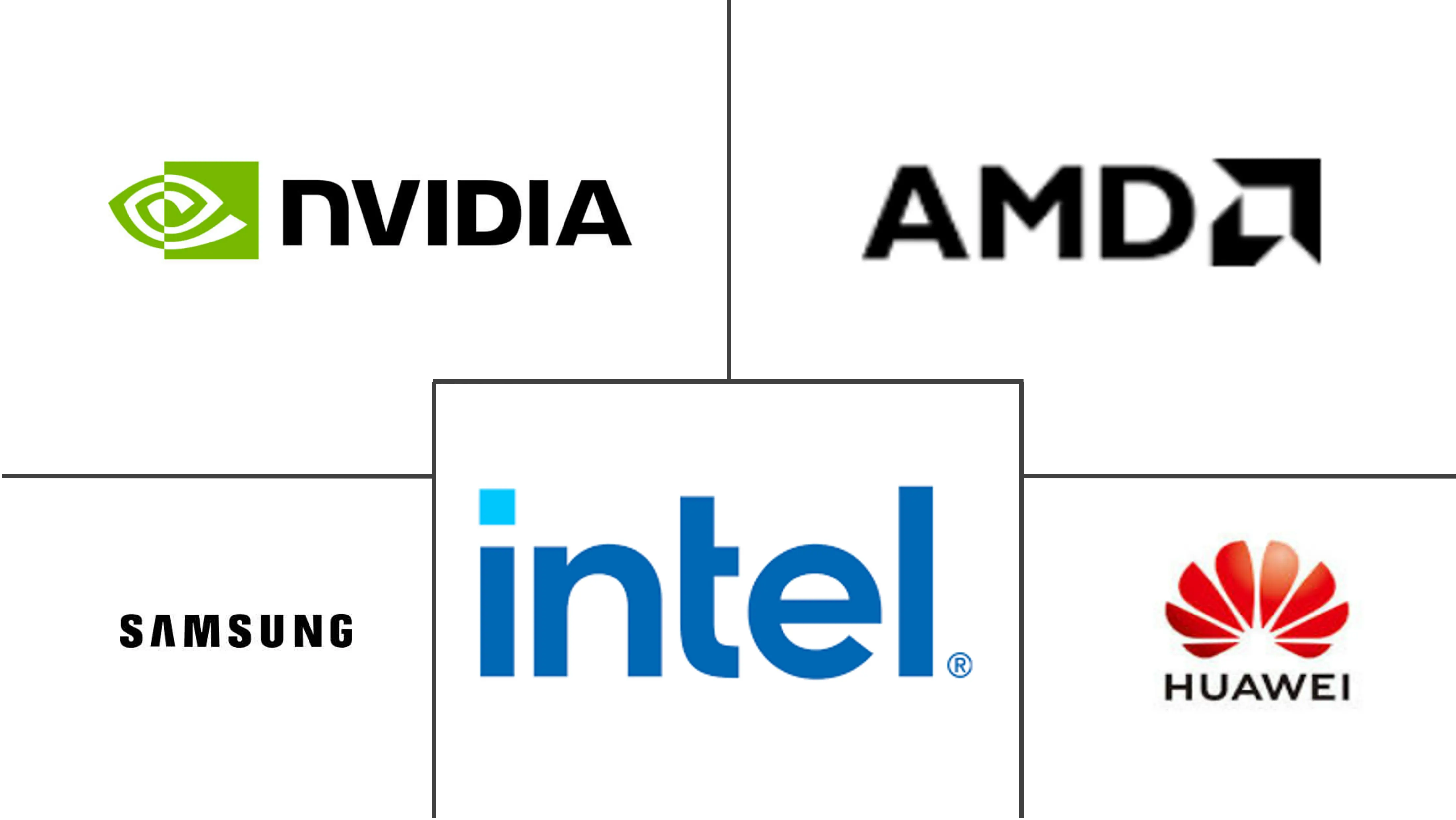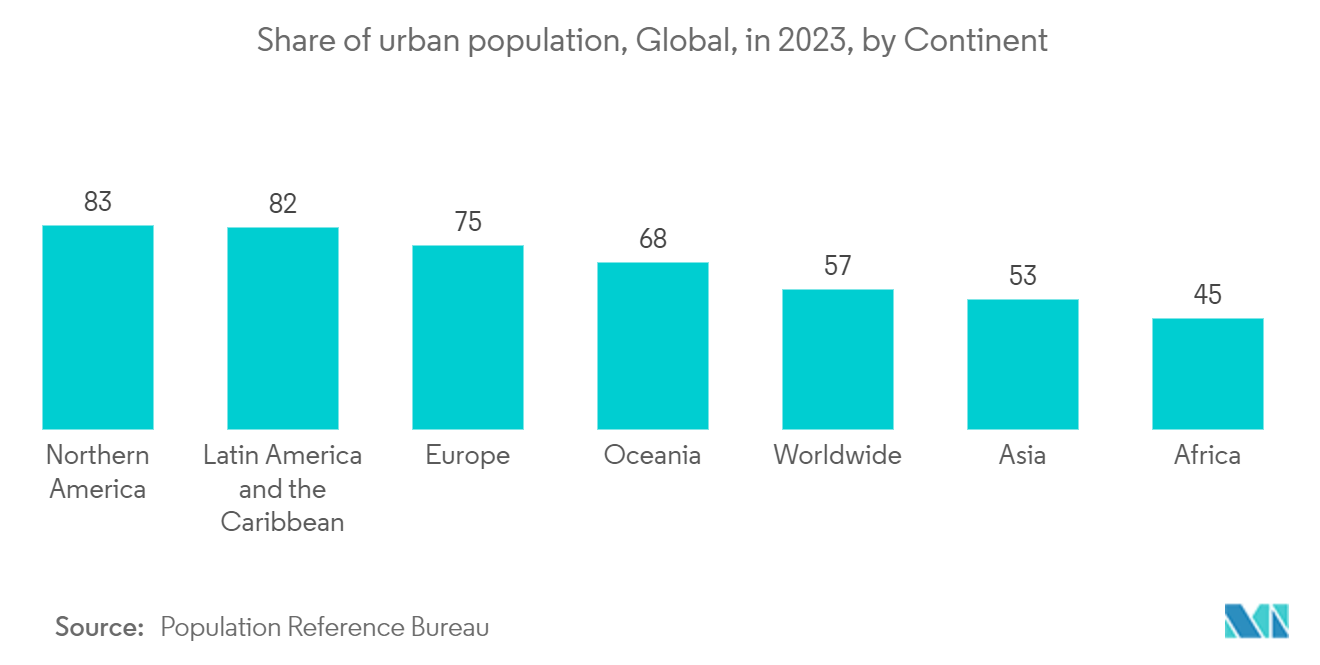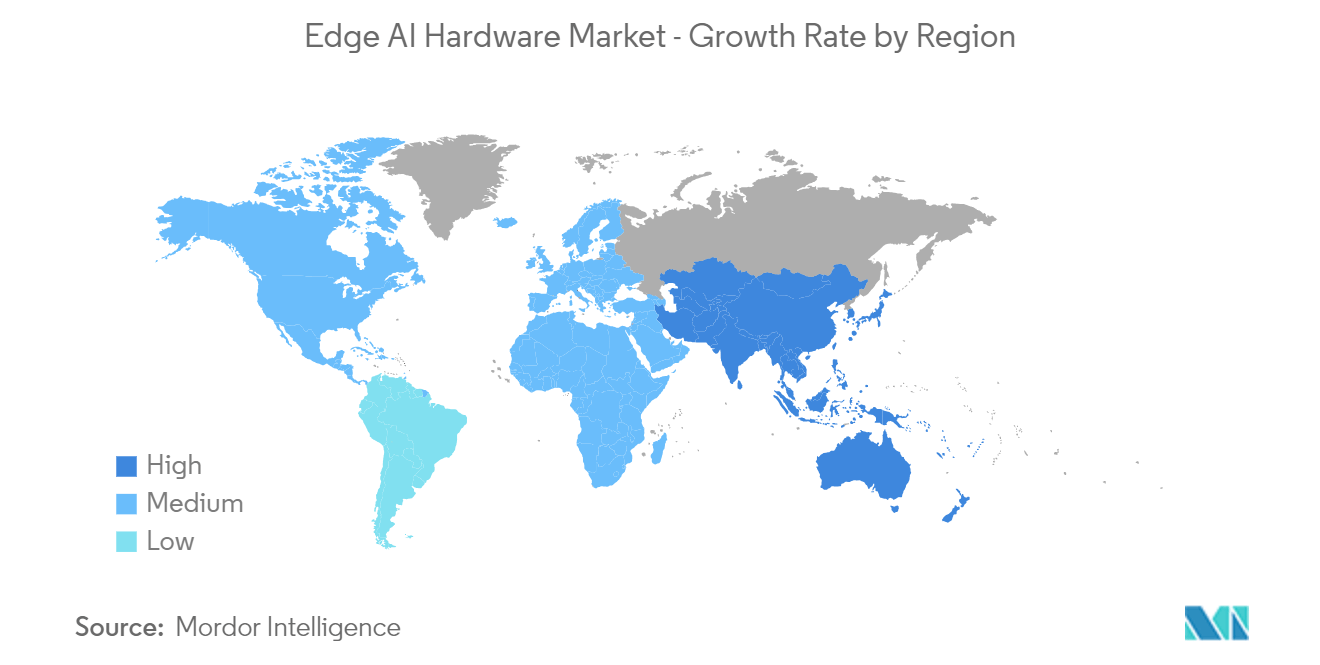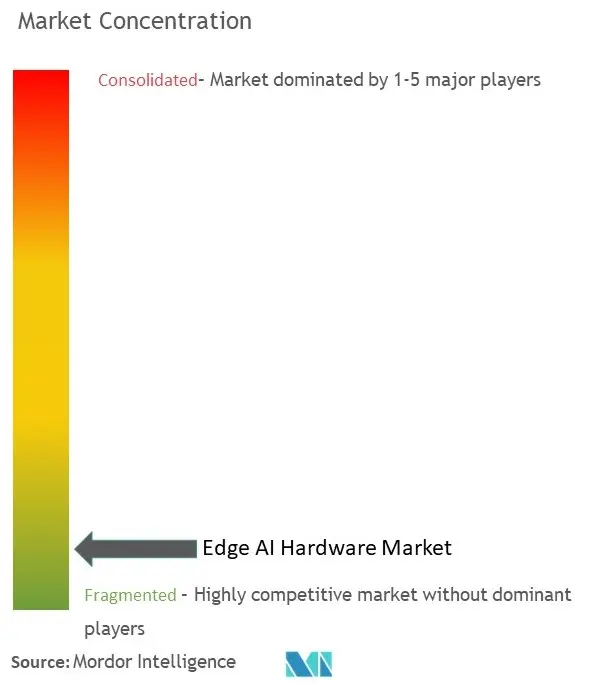Edge Artificial Intelligence (AI) Hardware Market Size

| Study Period | 2019 - 2029 |
| Market Size (2024) | USD 3.76 Billion |
| Market Size (2029) | USD 9.31 Billion |
| CAGR (2024 - 2029) | 19.85 % |
| Fastest Growing Market | Asia Pacific |
| Largest Market | North America |
Major Players
*Disclaimer: Major Players sorted in no particular order |
Edge Artificial Intelligence (AI) Hardware Market Analysis
The Edge AI Hardware Market size is estimated at USD 3.76 billion in 2024, and is expected to reach USD 9.31 billion by 2029, growing at a CAGR of 19.85% during the forecast period (2024-2029).
- Rapid growth in edge computing products and services and increasing real-time low latency on edge devices are significant factors for the edge AI hardware market growth. Notably, the need for edge computing in IoT and dedicated AI processors for on-device image analytics are promising areas of market advancement in edge AI devices.
- An edge Al device is an advanced system that processes and powers artificial intelligence-based robots and devices. Data processing is possible with this equipment by integrating artificial intelligence into it and improving its performance. The significant opportunities for the edge AI hardware market include the growing demand for IoT-based edge computing solutions, the rising adoption of 5G networks to bring IT and telecom together, and dedicated AI processors for on-device image analytics.
- The demand for edge AI is growing due to Industry 4.0's widespread deployment across all sectors. The burgeoning penetration of artificial intelligence, IoT & 5G technologies across varied industry verticals, including BFSI, government, hospitality, retail, and consumer goods, is speculated to support the growth of the edge AI Hardware industry. The possibility of performing AI inference without transferring data has generated huge demand for the edge AI Hardware market. Businesses can cut operating costs in critical situations when accuracy and latency are crucial due to the increase in edge AI devices.
- A trend in the edge AI hardware market anticipated to have a beneficial effect in the following years is the rise in demand for smart homes and smart cities. People can now control their homes from anywhere in the world using smart devices. Smart cities are being built using cutting-edge technology like AI, machine learning, big data, and blockchain. Because these technologies are becoming more prevalent across a wide range of industries, smart cities worldwide are increasingly adopting them. This pattern fuels the market for edge AI hardware.
- Security concerns related to edge AI devices are a restraining factor hindering the market's growth. The risk occurs at the local level, where edge AI functions primarily. Since it is open source to any online breaching from determined individuals, human error at the local level is prone to data loss. There is also a significant variation in machine types that are compatible with Edge AI programming, while some are incompatible. Unfortunately, it's likely for faults and failures to happen when incompatible machines work together, which restrains the market.
Edge Artificial Intelligence (AI) Hardware Market Trends
Increase Demand for Smart Homes and Smart Cities is Expected to Drive the Market Growth
- Smart cities are complex structures incorporating various systems to support a human life cycle. Smart healthcare, smart transportation, smart manufacturing, smart buildings, smart energy, and smart farming are just some of these systems. According to the Economist, In 2022, the leading global digital city on the index ranking was Copenhagen, with a score of 80.3. Seoul, Beijing, Amsterdam, and Singapore ranked in the top 5 for the best digital cities.
- As these AI technologies become more prevalent across various industries, smart cities are gradually adopting them worldwide. More people are becoming intrigued by the idea of a smart home as smart cities become more common. The need for automated services in people's daily lives is expected to rise as more people relocate to cities. Smart homes are evolving from a luxury to a need. Due to the increasing demand for smart homes and smart cities, the edge AI hardware market is anticipated to expand throughout the next five years.
- Globally, governments are utilizing cutting-edge technologies to handle the crucial issue of safeguarding the security and protection of residents. To take advantage of the opportunities presented by urbanization, many nations have developed programs to transform their cities into smart cities. Operational efficiencies, environmental sustainability, and the creation of new services for residents are all made possible by smart cities. For instance, the United Arab Emirates has started a program to make its cities smart cities. The UAE government has also developed a general blockchain strategy for improved security, immutability, resilience, and transparency. Drones and surveillance cameras are two leading-edge AI hardware deployed by government organizations for this purpose.
- Edge devices have become increasingly innovative because of increased edge computing power and the sparing use of deep learning and machine learning. Edge AI enables devices to deliver real-time insights and predictive analytics without sending data to distant cloud servers. Now, many companies are utilizing this by putting intelligent solutions in manufacturing. Manufacturers may be informed of problems in their supply chain and proactively avoid unplanned downtime with the help of the many industrial IoT devices installed in modern factories, which increases demand for the edge AI hardware market.

Asia Pacific is Expected to Hold Significant Market Share
- Asia Pacific region is expected to experience the highest growth rate in the global edge AI hardware market due to the advent of 5G in the region and the increasing number of IoT-incorporated devices. The growing penetration of smartphones in China, Japan, India, and South Korea is expected to increase the adoption of AI hardware market adoption.
- China is the largest market in the region, followed by Japan. The presence of several significant vendors in the automobile, electronics, and semiconductor companies, who are investing significantly in AI technology, is driving the growth of the edge AI hardware market in the region. China's edge AI industry has seen explosive growth in innovation in the last year for edge computing and hardware solutions through the number of patents filed, which shows that China's industries are innovating rapidly.
- During one month between June and July, the Beijing Municipal Commission of Economy and Information Technology counted around 4,040 AI companies in China. Besides, the presence of many manufacturing companies makes the region an attractive market for industrial robots that implement AI technology. Such trends strive for the demand for the edge AI hardware market.
- Wearable devices also play a significant role in the increasing demand for integration with vision processing units to accelerate AI tasks. Cisco Systems estimates that the number of connected wearable devices could reach 1,105 million units by the end of 2022. End-user industries like manufacturing, telecommunications, and automotive have huge potential in the region, creating a huge demand for the AI hardware market shortly.

Edge Artificial Intelligence (AI) Hardware Industry Overview
Edge AI Hardware Market is highly fragmented, with the presence of major players like Intel Corporation, Huawei Technologies Co. Ltd, Nvidia Corporation, Advanced Micro Devices Inc., and Samsung Group. Players in the market are adopting strategies such as partnerships and acquisitions to enhance their product offerings and gain sustainable competitive advantage.
- August 2023 - Intel and Synopsys announced their definitive agreement to expand the companies' long-standing IP (intellectual property) and EDA (electronic design automation) strategic partnership by developing a portfolio of IP on Intel 3 and Intel 18A for Intel's foundry customers. Synopsys would enable a range of its standardized interface IP portfolio on Intel's leading-edge process technologies as part of the transaction. As a result, Intel's foundry consumers would gain access to industry-leading IPs built on Intel's advanced process technologies and be able to accelerate design execution and project schedules for system-on-chips (SoCs).
- November 2022: Israeli AI solutions firm Run:ai has launched an MLOps Compute Platform (MCP) with support from NVIDIA's DGX systems. The platform is a full-stack AI tool for enterprises that would help them avoid issues associated with AI model deployment.
Edge Artificial Intelligence (AI) Hardware Market Leaders
-
Intel Corporation
-
Huawei Technologies Co. Ltd
-
Nvidia Corporation
-
Advanced Micro Devices Inc.
-
Samsung Group
*Disclaimer: Major Players sorted in no particular order

Edge Artificial Intelligence (AI) Hardware Market News
- July 2024 - VIA Technologies has teamed up with Rutronik to expand the reach of its advanced IoT, edge AI, and computer vision technologies, focusing on clientele in the industrial, retail, and commercial sectors. This collaboration is strategically timed, capitalizing on the rising demand for edge computing in sectors seeking real-time data processing and lower latencies in their IoT applications. VIA's intelligent edge solutions, featuring MediaTek Genio processors, present a versatile platform tailored to various applications.
- July 2024 - TRUMPF, one of the leading laser technology companies, and SiMa.ai, a software-centric firm specializing in embedded edge machine learning systems, have joined forces in a strategic partnership. The companies aim to infuse TRUMPF's laser systems with advanced artificial intelligence (AI) capabilities. The collaboration focuses on a range of applications, from welding and cutting to marking, and extends to TRUMPF's powder metal 3D printers.
Edge Artificial Intelligence (AI) Hardware Market Report - Table of Contents
1. INTRODUCTION
- 1.1 Study Assumptions and Market Definition
- 1.2 Scope of the Study
2. RESEARCH METHODOLOGY
3. EXECUTIVE SUMMARY
4. MARKET DYNAMICS
- 4.1 Market Overview
-
4.2 Market Drivers
- 4.2.1 Increasing Penetration of AI in Edge Devices
- 4.2.2 Increasing Demand for Smart Homes and Smart Cities
-
4.3 Market Restraints
- 4.3.1 Security Concerns Related to Edge AI Devices
- 4.4 Industry Value Chain Analysis
-
4.5 Industry Attractiveness - Porter's Five Force Analysis
- 4.5.1 Threat of New Entrants
- 4.5.2 Bargaining Power of Buyers/Consumers
- 4.5.3 Bargaining Power of Suppliers
- 4.5.4 Threat of Substitute Products
- 4.5.5 Intensity of Competitive Rivalry
- 4.6 Impact of COVID-19 on the Market
5. MARKET SEGMENTATION
-
5.1 By Processor
- 5.1.1 CPU
- 5.1.2 GPU
- 5.1.3 FPGA
- 5.1.4 ASICs
-
5.2 By Device
- 5.2.1 Smartphones
- 5.2.2 Cameras
- 5.2.3 Robots
- 5.2.4 Wearables
- 5.2.5 Smart Speaker
- 5.2.6 Other Devices
-
5.3 By End-User Industry
- 5.3.1 Government
- 5.3.2 Real Estate
- 5.3.3 Consumer Electronics
- 5.3.4 Automotive
- 5.3.5 Transportation
- 5.3.6 Healthcare
- 5.3.7 Manufacturing
-
5.4 By Geography***
- 5.4.1 North America
- 5.4.2 Europe
- 5.4.3 Asia
- 5.4.4 Australia and New Zealand
- 5.4.5 Latin America
- 5.4.6 Middle East and Africa
6. COMPETITIVE LANDSCAPE
-
6.1 Company Profiles*
- 6.1.1 Intel Corporation
- 6.1.2 Huawei Technologies Co. Ltd
- 6.1.3 Nvidia Corporation
- 6.1.4 Advanced Micro Devices Inc.
- 6.1.5 Baidu Inc.
- 6.1.6 Alphabet Inc.
- 6.1.7 Qualcomm Incorporated
- 6.1.8 Samsung Group
- 6.1.9 Apple Inc.
- 6.1.10 Amazon.com Inc.
- 6.1.11 Alibaba Group Holding Limited
- 6.1.12 Continental AG
- 6.1.13 Denso Corporation
- 6.1.14 Robert Bosch GmbH
- 6.1.15 KALRAY Corporation
- 6.1.16 MediaTek Inc.
- 6.1.17 Xilinx Inc.
7. INVESTMENT ANALYSIS
8. MARKET OPPORTUNITIES AND FUTURE TRENDS
** Subject To AvailablityEdge Artificial Intelligence (AI) Hardware Industry Segmentation
The scope for the edge AI hardware market primarily includes processors, sensors, and cameras that address the need for cognitive computing needs. These devices are used to power and process various AI-based devices. Multiple types of processors used in edge AI devices include semiconductor products such as central processing units (CPU), graphic processing units (GPU), field-programmable gate arrays (FPGA), and application-specific integrated circuits (ASICs).
The edge AI hardware market is segmented by processor (CPU, GPU, FPGA, ASIC), by device (smartphones, cameras, robots, wearables, smart speakers), by end-user industry (government, consumer electronics, real estate, automotive, transportation, healthcare, manufacturing), and by geography (North America, Europe, Asia Pacific, Rest of the World). The market sizes and forecasts are provided in terms of value in USD for all the above segments.
| By Processor | CPU |
| GPU | |
| FPGA | |
| ASICs | |
| By Device | Smartphones |
| Cameras | |
| Robots | |
| Wearables | |
| Smart Speaker | |
| Other Devices | |
| By End-User Industry | Government |
| Real Estate | |
| Consumer Electronics | |
| Automotive | |
| Transportation | |
| Healthcare | |
| Manufacturing | |
| By Geography*** | North America |
| Europe | |
| Asia | |
| Australia and New Zealand | |
| Latin America | |
| Middle East and Africa |
Edge Artificial Intelligence (AI) Hardware Market Research FAQs
How big is the Edge AI Hardware Market?
The Edge AI Hardware Market size is expected to reach USD 3.76 billion in 2024 and grow at a CAGR of 19.85% to reach USD 9.31 billion by 2029.
What is the current Edge AI Hardware Market size?
In 2024, the Edge AI Hardware Market size is expected to reach USD 3.76 billion.
Who are the key players in Edge AI Hardware Market?
Intel Corporation, Huawei Technologies Co. Ltd, Nvidia Corporation, Advanced Micro Devices Inc. and Samsung Group are the major companies operating in the Edge AI Hardware Market.
Which is the fastest growing region in Edge AI Hardware Market?
Asia Pacific is estimated to grow at the highest CAGR over the forecast period (2024-2029).
Which region has the biggest share in Edge AI Hardware Market?
In 2024, the North America accounts for the largest market share in Edge AI Hardware Market.
What years does this Edge AI Hardware Market cover, and what was the market size in 2023?
In 2023, the Edge AI Hardware Market size was estimated at USD 3.01 billion. The report covers the Edge AI Hardware Market historical market size for years: 2019, 2020, 2021, 2022 and 2023. The report also forecasts the Edge AI Hardware Market size for years: 2024, 2025, 2026, 2027, 2028 and 2029.
What future developments are expected in the Edge AI Hardware Market?
Future developments in the Edge Artificial Intelligence (AI) Hardware Market are a) More advanced neural network capabilities b) Increased integration with IoT devices c) Broader adoption across emerging industries like smart cities and logistics
What are the key drivers of the Edge AI Hardware Market?
Key factors driving the Edge Artificial Intelligence (AI) Market are a) Increasing demand for low-latency processing b) Advancements in AI and machine learning technologies c) Growing need for real-time decision-making solutions in various industries
Edge AI Hardware Industry Report
The global edge artificial intelligence hardware market is witnessing substantial growth, propelled by the increasing adoption of edge AI applications in sectors like healthcare, IT & telecom, consumer electronics, and automotive. This growth is driven by the integration of AI with edge computing, enabling real-time data processing and reduced latency, thus boosting IoT device efficiency. Key growth areas include smart healthcare, intelligent transportation, and smart factories. The AI hardware segment leads the market, spurred by the demand for IoT-based solutions and the expansion of 5G networks, which enhance edge connectivity and processing capabilities. North America holds a significant market share due to its advanced technological infrastructure and swift adoption of AI technologies. Meanwhile, the Asia-Pacific region is set to experience notable growth, fueled by the rising smartphone penetration and growth in industrial and automotive sectors adopting edge AI solutions. Leading edge AI companies are innovating and collaborating to expand their market presence. For comprehensive insights on edge AI market size and AI hardware market size, including a market forecast and historical data, download a free report PDF from Mordor Intelligence™ Industry Reports.



